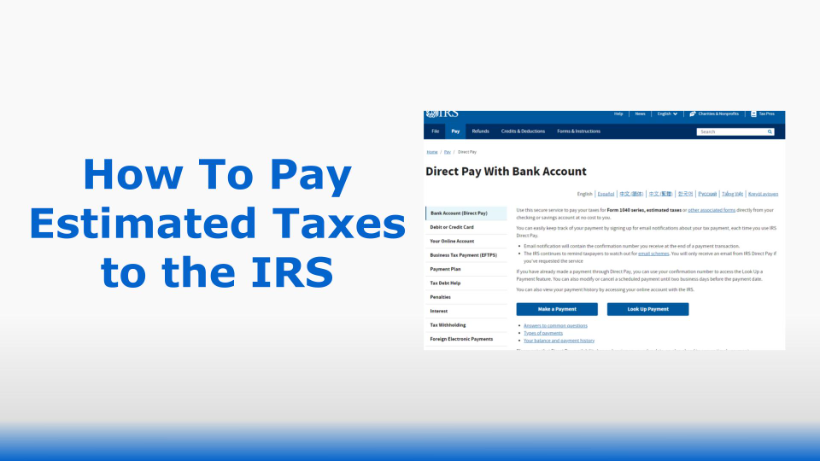
A fast tax penalty calculator? It’s the IRS, not hockey.
You need to accurately calculate your annual tax returns to avoid any potential penalties and interest.
However, it’s always possible to fall behind.
When that happens, it’s only natural to go looking for an estimate of how much you might owe for a late payment on income taxes. However, that’s only one type of penalty.
Whether you have a delinquent tax return, are undergoing an IRS examination, or are participating in a voluntary disclosure program, it’s natural to guesstimate your combined penalty and plan before getting an accurate tax return.
Looking for a tax calculator or late payment IRS penalty calculator can offer a preliminary sense of what you may owe. However, that time would be better spent getting your income taxes done and filing an accurate return as soon as possible.
Online IRS Penalty Calculators
You can use different online IRS penalty and interest calculators to estimate the amount you might owe the IRS for late tax payments. These calculators can help you understand estimated future penalties, deposit penalties, and more. However, it’s important to understand that online calculators can only offer estimations and may not be entirely accurate. The IRS itself does not offer a penalty and interest calculator online.
For the most accurate calculation of future penalties and interest, you should refer to your actual income tax return. Tax professional calculators can also provide a more precise estimate. Keep in mind that online calculators have limitations and can only give you a general idea of what you might owe.
The IRS Interest Rate Explained
The IRS interest rate is typically calculated by adding 3% to the federal short-term rate, which affects the interest rate on underpayments and overpayments for most individuals. This is determined annually and may vary from year to year.
The IRS interest rates are subject to change on a quarterly basis. It is expected that the IRS interest rate will continue to be calculated using the federal short-term rate, with the additional 3% remaining in place for most individuals. Any changes to the federal short-term rate will impact the overall IRS interest rate for the year.
What Types of Tax Penalties Are There?
You work hard to earn a living, but sometimes you may run into tax-related issues that could result in penalties. It’s important to be aware of the different types of tax penalties that exist, so you can avoid them and keep your finances in good standing with the government. In this article, we will explore the various types of tax penalties that you should be mindful of, and how you can prevent them from impacting your financial situation.
The IRS Failure to File Penalty
Yes, there are potential consequences and potential negative effects on your financial situation for failing to file your tax return on time. The IRS imposes late filing penalties if you do not file your tax return by the due date, including extensions. The late penalty is calculated based on the amount of unpaid taxes, and it can increase the longer you delay filing your return.
The calculation method is typically 5% of the unpaid taxes for each month or part of a month that the return is late, up to a maximum of 25% of the unpaid taxes. This means that the penalty for filing can add up quickly if you delay again on an already late return.
The maximum penalties can be significant, so it is important to take this one seriously. In addition to the financial impact, late tax returns can also result in other implications such as a hit on your credit history, if not potential legal consequences.
The IRS Failure to Pay Penalty
You may be subject to the failure to pay penalty if you do not pay the full amount of tax owed by the due date. The IRS charges 0.5% of the unpaid taxes for each month or part of a month that the tax remains unpaid, up to a maximum of 25% of the unpaid taxes — which is your total tax liability minus any allowed refundable credits
Underpayment penalties may increase in scenarios where you fail to set up a payment plan with the IRS or if you ignore their attempts to collect the unpaid taxes. However, there are options to reduce or eliminate this penalty. If you can show reasonable cause for not paying on time, such as a medical emergency or natural disaster, you may be able to request an abatement of the penalty. Additionally, if you can pay the remaining balance in full or set up a payment plan, you may be able to reduce the penalty. The IRS does publish an interest rate for underpayments of estimated tax by individuals.
By taking action to address your unpaid taxes, such as setting up a payment plan or demonstrating reasonable cause, you can work towards reducing or eliminating this penalty.
The IRS Accuracy-related Penalty
This penalty type can be imposed if the IRS finds that you were negligent or disregarded tax rules, resulting in substantial understatements of income tax. Negligence can include failing to keep adequate records or making mistakes on your annual tax return while disregard can involve intentionally not following tax laws.
If you are hit with this one, you could end up owing substantial amounts in interest and penalties, which can significantly increase the amount you owe. The amount owed in penalties and interest will depend on a variety of factors, including the amount of the underpayment, the length of the underpayment period, and your compliance history.
To avoid this penalty, be sure to carefully review your tax return for accuracy and seek professional help if needed. Keep accurate records and stay informed about any changes to tax laws. Being proactive and diligent with your tax obligations can help you avoid the costly consequences of an IRS Accuracy-Related Penalty.
The IRS Tax Penalty for Underpayment of Estimated Taxes
You can easily determine potential penalties for underpayment of estimated taxes using the IRS Penalty Calculator on the IRS website. The calculator takes into account various factors when calculating the penalty, including the amount of the underpayment, the number of days the underpayment remains unpaid, and the federal short-term rate.
To use the calculator, simply input the required information such as your estimated tax payments, actual tax liability, and the dates of your payments. The calculator will then provide you with an estimate of the penalty you may owe.
If you determine that you may owe a penalty for underpayment of estimated taxes, you may need to file Form 2210 to calculate the penalty using the Annualized Income Installment Method or the short method. This form will help you determine if you qualify for any waivers or exemptions to the underpayment penalty, more reliably than any tax calculator.
It’s important to stay informed about the potential penalties and waivers for underpayment of estimated taxes to avoid any surprises come tax time.
The IRS Failure to Deposit Penalty
You need to be aware of the IRS Failure to Deposit Penalty, which is imposed on employers who fail to make timely deposits of their employer-paid taxes. This penalty applies to federal income tax, Social Security tax, and Medicare tax, among others. The penalty for late deposits is a percentage of the amount of underpayment and can range from 2% to 15% depending on the number of days the deposit is late.
If you fail to deposit your employer-paid taxes on time, in the right amount, and/or in the right way, you can face serious consequences. Not only will you be subject to the Failure to Deposit Penalty, but you may also be liable for additional penalties and interest charges. It’s important to understand the calculation method and the types of taxes that are subject to this penalty in order to avoid any unnecessary costs.
In conclusion, it’s crucial to make your employment tax deposits on time and in the correct amounts to avoid the IRS Failure to Deposit Penalty. Failure to do so can result in substantial financial implications for your business. Be sure to stay informed about your tax obligations and take the necessary steps to comply with IRS regulations.
The IRS Has Plenty of Penalty Notices You Might Receive
If you make a mistake on your taxes or fail to file on time, the IRS has plenty of potential penalty notices that they can send your way. You may receive notices for failure to file, failure to pay, accuracy-related penalties, and more. For example, if you don’t file your tax return on time, you may get hit with the failure to file penalty, which can be up to 5% of the unpaid taxes for each month your return is late. If you fail to pay your taxes, you could face a failure to pay a penalty, which can be up to 25% of the unpaid taxes. Accuracy-related penalties can occur if you make substantial understatement of income tax or negligence in your tax return.
Common triggers for these notices include late or non-filed tax returns, underpayment of estimated taxes, and mathematical errors on your return. If you receive a penalty notice, it’s important to address the situation promptly. You can usually respond by paying the penalty, providing an explanation for why you believe the penalty is unjustified, or requesting an abatement. Make sure to take action to avoid further consequences from the IRS.
What to Do If You Think You Might Face Penalties and Interest
You need to take immediate action if you think you might face penalties and interest on your taxes.
Start by reviewing the applicable tax laws and regulations to understand what circumstances might lead to these charges. It’s crucial to consult with a tax professional to get personalized advice for your situation. You could also contact the Taxpayer Advocate Service, which is an independent organization within the IRS with the job to help taxpayers navigate difficult financial situations from tax liabilities.
If you are facing potential penalties and interest, it’s important to address the issue promptly. This may involve filing any overdue tax returns and paying any outstanding tax liabilities. By proactively taking these steps, you can potentially mitigate the impact of penalties and interest on your tax situation — as well as qualify for potential penalty relief.
Ignoring the possibility of penalties and interest will only make the situation worse. By understanding the tax laws and regulations and seeking professional guidance, you can take control of your tax situation and take the necessary steps to address any potential penalties and interest.

Sarah Nieschalk
Sarah E. Deierlein Nieschalk, EA, is an experienced tax professional with over a decade of expertise representing taxpayers before the IRS. As an Enrolled Agent and Assistant Vice President of Servicing at Community Tax, LLC, Sarah specializes in resolving complex federal and state tax collection issues, including high-dollar individual liabilities, employment tax challenges, and corporate audits. Since becoming an Enrolled Agent in 2012, she has resolved over 5,000 cases, saving millions for clients while protecting countless businesses. Outside of work, Sarah enjoys painting, staying active, and raising her family of rescued dogs while contributing to nonprofit causes through storytelling events.







